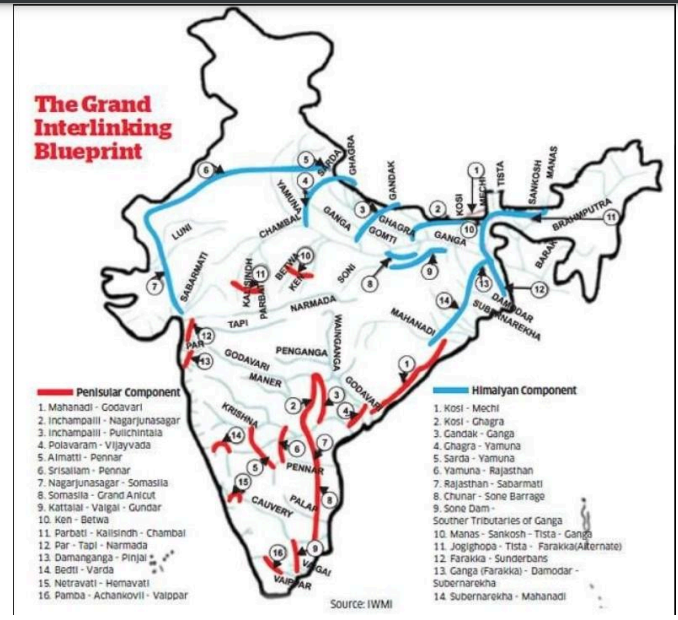
River linking, an ambitious project proposed in India, aims to interconnect rivers across the country to address water scarcity and flooding issues. However, this initiative presents a myriad of ecological and economic challenges that demand careful consideration. On one hand, altering natural river systems can disrupt ecosystems, endangering biodiversity and exacerbating environmental degradation. On the other hand, the economic feasibility of such a large-scale engineering endeavor remains uncertain, with concerns regarding cost-effectiveness, long-term sustainability, and potential social implications. Balancing the ecological integrity of river ecosystems with the economic benefits of water management poses significant challenges that must be thoroughly examined and addressed to ensure the well-being of both the environment and the communities reliant on these water resources.
Contents
Answer
Introduction:
River linking in India refers to the ambitious project aimed at interlinking rivers to address water scarcity and improve irrigation. The project involves diverting water from surplus rivers to deficit regions, but it comes with a set of ecological and economic challenges.

Body:
Ecological Challenges:
- Biodiversity Impact: Altering natural river courses can disrupt ecosystems, affecting flora and fauna adapted to specific river habitats.
- For instance, the Ken-Betwa river linking project involves submerging parts of the Panna Tiger Reserve, disrupting the habitat of various wildlife species.
- Aquatic Ecosystem Disruption: River linking may lead to changes in water flow patterns, impacting aquatic life and fisheries.
- The proposed interlinking of the Godavari and Krishna rivers could affect the migration patterns of fish species, impacting local fisheries and aquatic ecosystems.
- Soil Quality and Erosion: Altered water flows can influence sediment transport, potentially causing soil erosion and affecting agricultural lands.
- The alteration of water flow in the Damanganga-Pinjal river link may lead to soil erosion, jeopardizing agricultural productivity in affected regions.
- Water Quality Issues: Changes in river courses can impact water quality, affecting downstream regions with potential pollution and salinity concerns.
- The Damanganga-Pinjal link, by changing water courses, might introduce pollutants downstream, affecting water quality in Gujarat and Maharashtra.
- Wetland Displacement: River interlinking may threaten wetlands and their associated biodiversity, impacting migratory bird patterns.
- The Ken-Betwa project poses a threat to the Bori Wildlife Sanctuary and its associated wetlands, potentially disrupting the delicate balance of the ecosystem.
Economic Challenges:
- High Implementation Costs: River linking involves substantial infrastructural investments, posing a financial burden on the government and potential budget overruns.
- The National River Linking Project’s estimated cost of over $120 billion underscores the substantial financial burden the government faces in executing such projects.
- Relocation and Rehabilitation: Displacing communities for the project may require extensive rehabilitation efforts, adding to the overall cost.
- The Sardar Sarovar Dam project exemplifies the challenges of relocating communities, necessitating extensive rehabilitation efforts and incurring additional costs.
- Uncertain Benefits: The expected economic benefits, particularly in terms of increased agricultural productivity, are subject to uncertainties and may not be realized as anticipated.
- The Ken-Betwa project’s anticipated benefits in terms of increased agricultural productivity are uncertain, reflecting a broader issue of unpredictability in project outcomes.
- Legal and Inter-State Disputes: The project involves multiple states, leading to potential legal conflicts over water rights and usage.
- The Cauvery river dispute highlights the potential for legal conflicts between states over water rights and usage, complicating river linking initiatives.
- Maintenance Costs: The extensive canal network required for river linking demands ongoing maintenance expenses, which can strain financial resources.
- as observed in the Mahanadi-Godavari river link, demands ongoing maintenance expenses, straining financial resources.
Conclusion:
In the future, a more sustainable approach to river linking should integrate ecological conservation measures. Striking a balance between economic development and environmental preservation is crucial. Additionally, transparent inter-state agreements and effective management strategies can help mitigate disputes. A holistic water management approach considering both ecological and economic factors is imperative for the success and sustainability of river linking projects in India.
In case you still have your doubts, contact us on 9811333901.
For UPSC Prelims Resources, Click here
For Daily Updates and Study Material:
Join our Telegram Channel – Edukemy for IAS
- 1. Learn through Videos – here
- 2. Be Exam Ready by Practicing Daily MCQs – here
- 3. Daily Newsletter – Get all your Current Affairs Covered – here
- 4. Mains Answer Writing Practice – here

